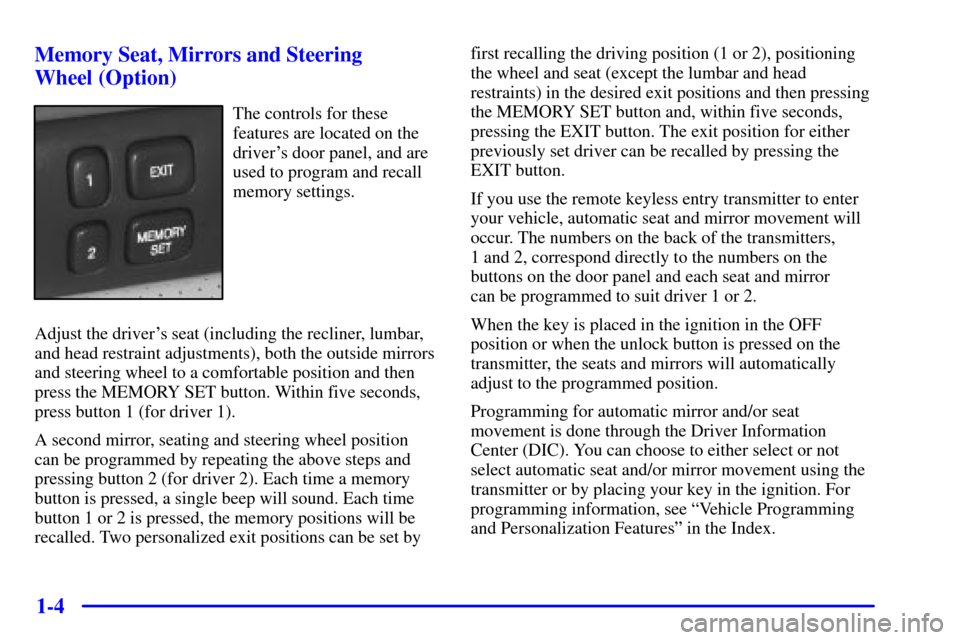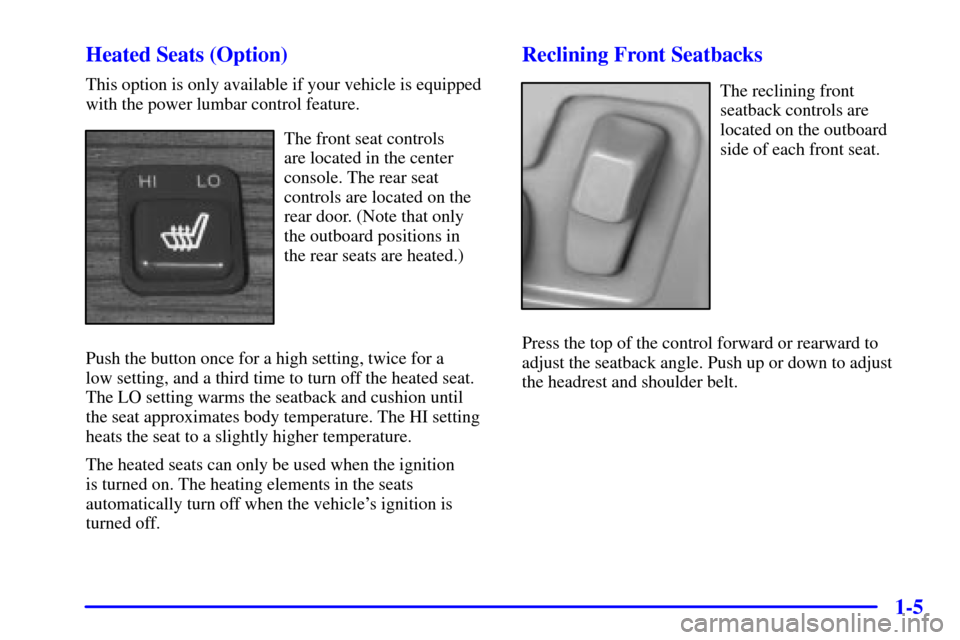Page 4 of 359
ii
Table of Contents
Keys and Door Locks
Remote Keyless Entry (RKE) System
Trunk Release
Automatic Transmission
Parking Brake
Windows
Tilt Wheel
Turn Signal/Multifunction Lever
Windshield Wipers
Cruise Control
Interior and Exterior LampsMirrors
Storage Compartments
Convenience Net
Accessory Power Outlets
OnStar® System (If Equipped)
Sunroof (Option)
HomeLink® Transmitter (Option)
Instrument Panel, Warning Lights and Gages
Driver Information Center
Memory and Personalization/Personal Choice Feature Seats and Seat Controls
Safety BeltsAir Bag Systems
Child Restraints
Section
1
Section
2
Seats and Restraint Systems
Features and Controls
Page 13 of 359
1-
1-1
Section 1 Seats and Restraint System
Here you'll find information about the seats in your vehicle and how to use your safety belts properly. You can also
learn about some things you should not do with air bags and safety belts.
1
- 2 Seats and Seat Controls
1
- 7 Safety Belts: They're For Everyone
1
- 12 Here are Questions Many People Ask About
Safety Belts
-- and the Answers
1
- 13 How to Wear Safety Belts Properly
1
- 13 Driver Position
1
- 19 Safety Belt Use During Pregnancy
1
- 20 Right Front Passenger Position
1
- 20 Supplemental Inflatable Restraint
(SIR) Systems1
- 29 Safety Belt Pretensioners
1
- 29 Rear Seat Passengers
1
- 32 Children
1
- 35 Child Restraints
1
- 45 Larger Children
1
- 48 Safety Belt Extender
1
- 48 Checking Your Restraint Systems
1
- 48 Replacing Restraint System Parts After
a Crash
Page 14 of 359

1-2
Seats and Seat Controls
This section tells you about the power seats -- how to
adjust them, and also about reclining front seatbacks,
lumbar adjustments, heated seats and head restraints.
Power Seats
The power seat controls are
located on the outboard side
of the front seat cushions.
�Move the front of the seat control up or down to
adjust the front portion of the cushion.
�Move the rear of the seat control up or down to
adjust the rear portion of the cushion.
�Lift up or push down on center of the seat control to
move the entire seat up or down.
�To move the seat forward or rearward, slide the seat
control forward or rearward.
Four Way Power Lumbar Control
(If Equipped)
If you have this feature,
the driver's and passenger's
seatback lumbar support
can be adjusted four ways
by moving a single switch
located on the side of
the seat.
To increase or decrease support, hold the switch forward
or rearward. To move the lumbar up or down, hold the
switch up or down.
Keep in mind that as your seating position changes,
as it may during long trips, so should the position of
your lumbar support. Adjust the seat as needed.
Page 16 of 359

1-4 Memory Seat, Mirrors and Steering
Wheel (Option)
The controls for these
features are located on the
driver's door panel, and are
used to program and recall
memory settings.
Adjust the driver's seat (including the recliner, lumbar,
and head restraint adjustments), both the outside mirrors
and steering wheel to a comfortable position and then
press the MEMORY SET button. Within five seconds,
press button 1 (for driver 1).
A second mirror, seating and steering wheel position
can be programmed by repeating the above steps and
pressing button 2 (for driver 2). Each time a memory
button is pressed, a single beep will sound. Each time
button 1 or 2 is pressed, the memory positions will be
recalled. Two personalized exit positions can be set by first recalling the driving position (1 or 2), positioning
the wheel and seat (except the lumbar and head
restraints) in the desired exit positions and then pressing
the MEMORY SET button and, within five seconds,
pressing the EXIT button. The exit position for either
previously set driver can be recalled by pressing the
EXIT button.
If you use the remote keyless entry transmitter to enter
your vehicle, automatic seat and mirror movement will
occur. The numbers on the back of the transmitters,
1 and 2, correspond directly to the numbers on the
buttons on the door panel and each seat and mirror
can be programmed to suit driver 1 or 2.
When the key is placed in the ignition in the OFF
position or when the unlock button is pressed on the
transmitter, the seats and mirrors will automatically
adjust to the programmed position.
Programming for automatic mirror and/or seat
movement is done through the Driver Information
Center (DIC). You can choose to either select or not
select automatic seat and/or mirror movement using the
transmitter or by placing your key in the ignition. For
programming information, see ªVehicle Programming
and Personalization Featuresº in the Index.
Page 17 of 359

1-5 Heated Seats (Option)
This option is only available if your vehicle is equipped
with the power lumbar control feature.
The front seat controls
are located in the center
console. The rear seat
controls are located on the
rear door. (Note that only
the outboard positions in
the rear seats are heated.)
Push the button once for a high setting, twice for a
low setting, and a third time to turn off the heated seat.
The LO setting warms the seatback and cushion until
the seat approximates body temperature. The HI setting
heats the seat to a slightly higher temperature.
The heated seats can only be used when the ignition
is turned on. The heating elements in the seats
automatically turn off when the vehicle's ignition is
turned off.
Reclining Front Seatbacks
The reclining front
seatback controls are
located on the outboard
side of each front seat.
Press the top of the control forward or rearward to
adjust the seatback angle. Push up or down to adjust
the headrest and shoulder belt.
Page 19 of 359

1-7 Head Restraints
The switches to move your
head restraints are located
on the outboard side of
each front seat.
Use this switch to move a front head restraint up or
down. Lift up on the switch to move the head restraint
up. Press down on the switch to move the head restraint
down. The top of the head restraint should be closest to
the top of your ears. This position helps reduce the
chance of a neck injury in a crash. When you move a
front seat head restraint up or down, the shoulder belt
height changes.The head restraints tilt forward and rearward also.
To tilt the head restraints forward, grasp the top of the
restraint and move it forward to where you want it to go
until you hear a click. It will then be locked into that
position until you need to move it again. Pulling forward
past the last position will allow the restraint to return to
an upright position.
Some rear seats have adjustable head restraints.
Slide an adjustable head restraint up or down so that
the top of the restraint is closest to the top of your
ears. This position reduces the chance of a neck injury
in a crash.
The head restraints tilt forward and rearward also.
Safety Belts: They're for Everyone
This part of the manual tells you how to use safety belts
properly. It also tells you some things you should not do
with safety belts.
And it explains the Supplemental Inflatable Restraint (SIR),
or air bag system.
Page 20 of 359

1-8
CAUTION:
Don't let anyone ride where he or she can't wear
a safety belt properly. If you are in a crash and
you're not wearing a safety belt, your injuries
can be much worse. You can hit things inside the
vehicle or be ejected from it. You can be seriously
injured or killed. In the same crash, you might
not be if you are buckled up. Always fasten your
safety belt, and check that your passengers' belts
are fastened properly too.
CAUTION:
It is extremely dangerous to ride in a cargo area,
inside or outside of a vehicle. In a collision, people
riding in these areas are more likely to be seriously
injured or killed. Do not allow people to ride in
any area of your vehicle that is not equipped with
seats and safety belts. Be sure everyone in your
vehicle is in a seat and using a safety belt properly.
Your vehicle has a light
that comes on as a reminder
to buckle up. (See ªSafety
Belt Reminder Lightº in
the Index.)
In most states and Canadian provinces, the law says to
wear safety belts. Here's why: They work.
You never know if you'll be in a crash. If you do have
a crash, you don't know if it will be a bad one.
A few crashes are mild, and some crashes can be so
serious that even buckled up a person wouldn't survive.
But most crashes are in between. In many of them,
people who buckle up can survive and sometimes
walk away. Without belts they could have been badly
hurt or killed.
After more than 30 years of safety belts in vehicles,
the facts are clear. In most crashes buckling up does
matter ... a lot!
Page 25 of 359

1-13
How to Wear Safety Belts Properly
Adults
This part is only for people of adult size.
Be aware that there are special things to know about
safety belts and children. And there are different rules for
smaller children and babies. If a child will be riding in
your vehicle, see the part of this manual called ªChildren.º
Follow those rules for everyone's protection.
First, you'll want to know which restraint systems your
vehicle has.
We'll start with the driver position.
Driver Position
This part describes the driver's restraint system.
Lap-Shoulder Belt
The driver has a lap-shoulder belt. Here's how to
wear it properly.
1. Close and lock the door.
2. Adjust the seat (to see how, see ªSeatsº in the Index)
so you can sit up straight.
3. Pick up the latch plate and pull the belt across you.
Don't let it get twisted.
The lap
-shoulder belt may lock if you pull the belt
across you very quickly. If this happens, let the belt
go back slightly to unlock it. Then pull the belt
across you more slowly.